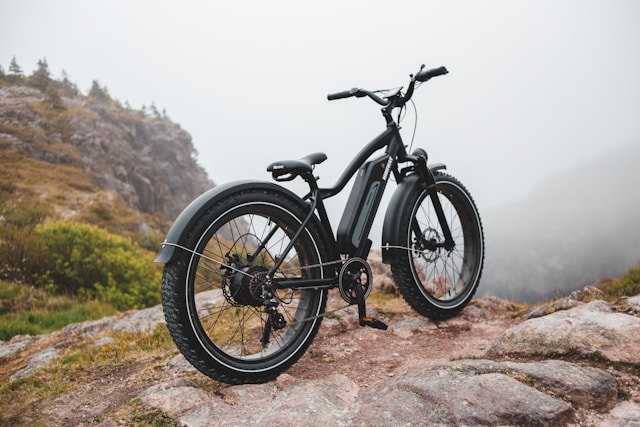How To Reset Electric Bike Battery
Last Updated on April 16, 2024 by Kristina Grant
Whether you’re a seasoned rider or just starting out, one thing we can all agree on is the sheer joy and convenience that electric bikes bring to our lives. But what happens when your trusty battery starts acting up? Don’t worry, my friend, because today we’re going to dive into the world of resetting electric bike batteries and getting you back on the road in no time.
Understanding Electric Bike Batteries
First things first, let’s talk a bit about the different types of electric bike batteries out there. You’ve probably heard of lithium-ion batteries, which are the most common type used in e-bikes. These batteries are light, have high energy density, and provide a good balance between power and endurance.
Now, how do these batteries work, you ask? Well, it’s quite fascinating! Inside your battery pack, you’ll find a collection of individual cells. These cells store energy in chemical form and release it as electrical energy when you need a boost. Pretty cool, right?
Unfortunately, even the best batteries can sometimes encounter issues. Maybe you’ve noticed reduced range or power output, difficulty charging, or even inaccurate battery level indicators. This is where a battery reset comes in handy!
Signs That Your Electric Bike Battery Needs a Reset
Before we jump into the how-to, it’s important to recognize the signs that indicate your electric bike battery needs a good ol’ reset. One of the most common indicators is a reduced range and power output. If you’re finding yourself pedaling harder than usual or your bike isn’t traveling as far, it’s time to take action.
Another sign to look out for is difficulty charging the battery. If you notice that the charging process takes longer than it used to or the battery doesn’t fully charge, it’s a clear signal that something’s amiss. Inaccurate battery level indicators, where the reading on your bike’s display doesn’t match the actual battery capacity, are also a sign of an issue.
Of course, there might be other telltale signs that something is wrong with your battery. It may be overheating, displaying error messages, or just not functioning as it should. Pay attention to these signals, my friend, as they’re your battery’s way of saying “help me, I need a reset!”
Before You Reset
Now, let’s get ready for the battery reset process. But before we jump straight in, we need to cover a couple of important points. Safety first, remember? Make sure to wear protective gloves and goggles when handling the battery. It’s better to be safe than sorry!
Next, let’s gather the proper tools and equipment you’ll need for the reset. You’ll want a set of hex keys or screwdrivers to remove the battery from your bike, depending on the fastening mechanism used. Keep these tools handy, as they’ll be your trusty sidekicks throughout the reset adventure.
Lastly, it’s essential to determine if a reset is necessary. Start by inspecting the battery for any physical damage or loose connections. Check that the battery and charger are compatible and that you’re following the correct charging instructions. If all seems well and the issues persist, it’s time to jump into action.
Methods to Reset an Electric Bike Battery
Alright, my friend, it’s time to dive into the methods for resetting your electric bike battery. We’ll start with some simple resets for minor issues that you can try on your own. If these don’t do the trick, don’t fret! We’ll also explore more advanced resets.
Simple Resets for Minor Issues
- Disconnecting and reconnecting the battery: This basic reset can often resolve minor issues. Start by turning off your bike and carefully removing the battery. Give it a few minutes, then reconnect the battery firmly, ensuring a secure connection. This simple reset might just do the trick!
- Performing a power-cycle reset: Let’s say your battery seems to have lost its mojo. A power-cycle reset might just revitalize it! Start by fully charging your battery. Once charged, disconnect the charger and turn on your bike. Let it run until the battery is completely drained. Then, give it a full charge again. This power cycle helps recalibrate the battery’s internal systems and can restore its performance.
Advanced Resets for More Complex Issues
Okay, so the simple resets didn’t quite cut it. Don’t worry, we’ve got a few more tricks up our sleeves. These advanced resets are for more complex issues that require a little extra TLC.
- Diagnosing and fixing cell imbalances: Sometimes, the battery cells can become imbalanced, leading to reduced performance. To fix this, you’ll need a specialized tool called a cell balancer. Connect the cell balancer to your battery and follow the manufacturer’s instructions to balance the cells.
- Balancing battery voltage using a specialized charger: If your battery’s voltage is unbalanced, it can cause issues. A specialized charger with a balancing feature can help restore balance to the battery pack. Connect the charger and let it do its magic, ensuring all cells are equally charged.
- Resetting the battery management system (BMS): The BMS is responsible for monitoring and protecting your battery. However, it can sometimes get confused and need a reset. Check your bike’s manual for instructions on how to reset the BMS. It’s usually a combination of button presses or switch manipulation.
- Calibrating battery capacity and range estimate: If your battery’s capacity and the bike’s range estimate are out of sync, it’s time to calibrate. Drain the battery until it’s completely empty, then give it a full charge. This process helps the battery and bike’s systems align with each other and provide accurate readings.
- Replacing faulty battery components: In rare cases, the battery might have a faulty component that requires replacement. If you’ve exhausted all other options and the issues persist, it’s time to consult a professional or contact the manufacturer for guidance on replacing specific components.
Remember, my friend, these advanced resets should only be attempted if you’re comfortable and have the necessary knowledge. If you’re ever unsure or uncomfortable performing these actions, seek help from a professional.
Maintaining Your Electric Bike Battery’s Health
Now that we’ve covered the necessaries of resetting your electric bike battery, let’s talk about how you can keep it in great shape for the long haul. Regular maintenance is key to ensuring optimal performance and longevity for your battery.
Regular cleaning and inspections are crucial. Gently wipe down the battery with a damp cloth to remove any dirt or debris that may have accumulated. Check for any signs of physical damage, such as cracks or bulging, and address them immediately.
When it comes to charging and discharging, it’s important to follow best practices. Avoid overcharging your battery, as this can shorten its lifespan. Stick to the recommended charging times and never leave your battery plugged in for longer than necessary. Similarly, don’t let your battery fully discharge regularly, as this can also impact its overall health. Aim to keep your battery between 20-80% capacity for optimal performance.
Proper storage is equally important. If you won’t be using your bike for an extended period, store the battery in a cool, dry place away from direct sunlight or extreme temperatures. A temperature range of 20-25°C (68-77°F) is ideal for battery storage.
Lastly, incorporating some preventive maintenance tips into your routine can go a long way. Avoid exposing your battery to extreme temperatures, as heat can accelerate its aging process. Be mindful of riding on rough terrains and try to minimize impacts and vibrations that may affect the battery’s internal components. And of course, always refer to your bike’s user manual for specific maintenance recommendations.
Troubleshooting Common Battery Issues
Sometimes, despite your best efforts, you may still encounter common battery issues. Let’s troubleshoot a few of the most frequent ones and give you some tips on how to address them.
Battery not holding a charge: If you find that your battery isn’t holding a charge as it should, start by double-checking your charging practices. Make sure you’re using the correct charger and following the recommended charging times. If the problem persists, it may be time to replace your battery.
Reduced range and power output: If your battery isn’t providing the same range and power as before, it could be a sign of degraded cells. Consider performing a cell balancing procedure or consulting a professional to assess potential cell replacement.
Overheating battery: An overheating battery is a cause for concern and should be addressed promptly. Check for any obstructions that may be blocking airflow around the battery. Additionally, ensure that your bike isn’t operating in extreme temperatures. If the issue continues, contact the manufacturer or a bike technician for assistance.
Error messages and fault codes: If your bike displays error messages or fault codes, refer to your bike’s manual for information on what they mean. Often, these messages indicate an underlying issue that requires attention from a professional or manufacturer support.
Can Resetting the Electric Bike Also Reset the Electric Bike Battery?
Yes, resetting the electric bike can also reset the electric bike battery. When you reset the electric bike, it can help recalibrate the battery management system and improve its performance. This can potentially improve the overall lifespan and efficiency of the resetting electric bike battery.
Seeking Professional Help
While we’ve covered many troubleshooting methods and maintenance tips, there may come a time when professional help is needed. It’s important to know when to seek expert assistance.
If you’ve tried all the suggested resets and your battery continues to exhibit issues, it’s a good idea to reach out to a reputable electric bike service center. Research and choose a service center known for their expertise in electric bikes. Ask for recommendations from fellow riders or check online reviews to ensure you’re entrusting your bike to capable hands.
Before committing to a service center, it’s wise to ask a few questions to gauge their suitability. Inquire about their experience in handling electric bike batteries, their turnaround time for repairs, and any additional costs involved. Don’t hesitate to get all the information you need to feel confident about their services.
My friend, we’ve covered a lot today on the topic of resetting your electric bike battery. We’ve explored different types of batteries, signs that indicate a reset is necessary, and various reset methods for both minor and complex issues. We’ve also delved into maintenance tips, troubleshooting common battery problems, and knowing when to seek professional assistance.
Remember, maintaining a healthy battery is essential for a smooth and enjoyable riding experience. By following proper storage, charging, and maintenance practices, you’ll keep your battery performing at its best for many miles to come.
So, the next time you encounter battery issues, don’t panic! Refer back to this guide, gather your tools, and give your electric bike battery the reset it needs. You’ll be back on the road, enjoying the wind in your hair and the thrill of an electric boost, in no time!
Tips and Tricks for Maximizing Your Electric Bike Battery Life
Before we wrap up, let’s dive into some bonus tips and tricks that will help you get the most out of your electric bike battery and extend its lifespan.
- Keep an eye on battery temperature: Extreme temperatures, whether hot or cold, can affect battery performance. In hot weather, try to park your electric bike in the shade or in a cooler area. Similarly, in cold weather, consider insulating the battery with a neoprene cover or storing it indoors when not in use.
- Plan your routes wisely: When you’re going on longer rides, be mindful of the terrain and plan your routes accordingly. Avoid steep uphill climbs, as they can drain the battery quickly. Instead, look for flatter routes or take advantage of electric assist for uphill sections to help preserve your battery.
- Take it easy on the throttle: While it may be tempting to use the highest assist level and cruise at top speed, remember that it will drain your battery faster. Opt for lower assist levels when you can, use the throttle sparingly, and rely more on pedal-assist to maximize your battery’s efficiency.
- Adjust your riding style: Small changes in your riding style can have a significant impact on your battery’s range. Start by pedaling smoothly instead of relying solely on the throttle. Use gears to maintain an optimal cadence and minimize strain on the motor. By being conscious of your riding style, you can conserve energy and get more miles from your battery.
- Keep your tires properly inflated: Maintaining the right tire pressure not only enhances your riding experience but also affects battery efficiency. Check your tire pressure regularly and ensure they are inflated to the manufacturer’s recommended levels. Properly inflated tires reduce rolling resistance, allowing your battery to work more efficiently.
- Invest in regenerative braking: Some electric bikes come equipped with regenerative braking technology. This feature converts braking energy into electricity and sends it back to the battery, essentially recharging it during rides. If your bike has this capability, make the most of it by engaging the regenerative braking system whenever possible.
- Use your bike’s eco-friendly features: Many electric bikes offer eco modes or power-saving options that help conserve battery life. Explore your bike’s settings and see if you can adjust the power output to a more eco-friendly level. This can be especially useful on rides where you don’t require maximum power and want to extend your battery’s range.
- Plan your charging schedule: When charging your battery, it’s best to avoid leaving it connected overnight or for extended periods. Instead, try to time your charges so that the battery reaches full capacity just before you plan to ride. This prevents the battery from sitting fully charged for too long, which can lead to wear and degradation over time.
- Be mindful of weight: The overall weight on your electric bike, including both the rider and any additional cargo, can impact its battery life. Consider shedding some unnecessary weight before each ride to help improve efficiency. Lightening the load will reduce the strain on the battery and allow you to travel farther.
- Stay regular with maintenance: Regular maintenance is key to the longevity and performance of your electric bike battery. Just as you’d maintain your bike’s chain, brakes, and gears, don’t forget to give your battery the attention it deserves. Clean it regularly, inspect for any signs of damage, and follow the manufacturer’s recommended maintenance guidelines to ensure optimal performance.
Conclusion
You’ve now equipped yourself with knowledge on how to reset your electric bike battery, troubleshoot common issues, and maximize its lifespan. By following the tips and tricks we’ve shared, you’ll be well on your way to enjoying many miles of worry-free electric bike adventures.
Remember, a healthy battery is the key to unlocking the full potential of your electric bike. Take the time to care for your battery and stay on top of maintenance practices. With proper care, your battery will provide you with countless rides filled with joy, convenience, and the refreshing feeling of the wind in your face.
Get out there, embrace the electric revolution, and pedal on, my friend. Until next time, happy riding!
Kristina Grant is not just an enthusiast but a true authority on electric bikes. Nestled in the coastal beauty of Virginia, Kristina has found the perfect backdrop for her passion for electric biking. As a dedicated wife and homeschooling mom, her life revolves around family, faith, and the thrill of adventure.
Originally hailing from Ohio, Kristina's journey with electric bikes began as a curiosity and quickly evolved into a deep expertise. Her blog is a testament to her love for electric biking, combining her fascination for eco-friendly transportation with her coastal lifestyle.
When she's not cruising the beach on her electric bike, you'll find Kristina indulging in her other loves: long walks along the shore, getting lost in a good book, and cherishing moments with her loved ones. With a heart as big as her love for animals, especially cats, Kristina brings a unique perspective to the electric bike world, grounded in her strong faith in God and her dedication to a sustainable lifestyle.
Through her blog, Kristina shares her extensive knowledge of electric bikes, offering valuable insights, tips, and recommendations to fellow enthusiasts. Whether you're a seasoned rider or a newcomer to the electric bike scene, Kristina's blog is your go-to source for all things electric biking, fueled by her passion, expertise, and the scenic beauty of coastal Virginia.






